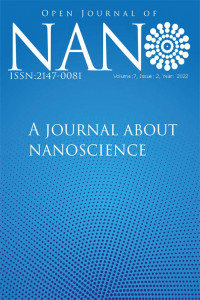Öz
The treatment of boron(III) subphthalocyanine chloride (SubPcCl) with borondipyrromethene (BODIPY) derivative consisting one pyrene group in toluene gave the corresponding axially substituted boron(III) subphthalocyanine dyad (SubPcBodiPy). Novel compound has been fully characterized by FTIR, mass, NMR (1H and 13C) spectroscopy and elemental analysis. Photophysical properties of SubPcBodiPy was investigated and compared with its precursors by fluorescence and absorption spectroscopy in THF. Accordingly, fluorescence lifetimes were measured directly by single exponential calculation.
Anahtar Kelimeler
Kaynakça
- Ward M. D., (1997) “Photo-induced electron and energy transfer in non-covalently bonded supramolecular assemblies”, Chemical Society Reviews, vol.26, pp.365-375.
- Balzani V., Bergamini G., Ceroni P., (2008) “From the photochemistry of coordination compounds to light-powered nanoscale devices and machines”, Coordination Chemistry Reviews, vol. 252, pp.2456-2469.
- Holten D., Bocian D. F., Lindsey J. S., (2002) “Probing electronic communication in covalently linked multiporphyrin arrays. A guide to the rational design of molecular photonic devices” Accounts of Chemical Research, vol.35, pp.57-69.
- Loudet A., Burgess K., (2007) “BODIPY dyes and their derivatives: syntheses and spectroscopic properties” Chemical Reviews, vol.107, pp.4891-4932.
- Claessens C. G., González-Rodríguez D., Torres T., (2002) “Subphthalocyanines: singular nonplanar aromatic compounds synthesis, reactivity, and physical properties” Chemical Reviews, vol.102, pp.835-854.
- Mutolo K.L., Mayo E.I., Rand B.P., Forrest S.R., Thompson M.E., (2006) “Enhanced opencircuit voltage in subphthalocyanine/C60 organic photovoltaic cells” Journal of American Chemical Society, vol.128, pp.8108-8109.
- Xu S., Chen K., Tian H., (2005) “A colorimetric and fluorescent chemodosimeter: fluoride ion sensing by an axial-substituted subphthalocyanine” Journal of Materials Chemistry A, vol.15, pp.2676-2680.
- Morse G. E., Helander M. G., Maka J. F., Lu Z. H., Bender T. P., (2010) “Fluorinated phenoxy boron subphthalocyanines in organic light-emitting diodes” ACS Applied Materials & Interfaces, vol.2(7), pp.1934-1944.
- Renshaw K. C., Xu X., Forrest S. R., (2010) “A monolithically integrated organic photodetector and thin film transistor” Organic Electronics, vol.11, pp.175-178.
- Li J. Y., Yeung H. S., Xu W., Li X., Ng D. K. P. (2008) “Highly Efficient Energy Transfer in Subphthalocyanine−BODIPY Conjugates” Organic Letters, vol.10, 23, pp.5421–5424.
Öz
The treatment of boron(III) subphthalocyanine chloride (SubPcCl) with borondipyrromethene (BODIPY) derivative consisting one pyrene group in toluene gave the corresponding axially substituted boron(III) subphthalocyanine dyad (SubPcBodiPy). Novel compound has been fully characterized by FTIR, mass, NMR (1H and 13C) spectroscopy and elemental analysis. Photophysical properties of SubPcBodiPy was investigated and compared with its precursors by fluorescence and absorption spectroscopy in THF. Accordingly, fluorescence lifetimes were measured directly by single exponential calculation.
Anahtar Kelimeler
Kaynakça
- Ward M. D., (1997) “Photo-induced electron and energy transfer in non-covalently bonded supramolecular assemblies”, Chemical Society Reviews, vol.26, pp.365-375.
- Balzani V., Bergamini G., Ceroni P., (2008) “From the photochemistry of coordination compounds to light-powered nanoscale devices and machines”, Coordination Chemistry Reviews, vol. 252, pp.2456-2469.
- Holten D., Bocian D. F., Lindsey J. S., (2002) “Probing electronic communication in covalently linked multiporphyrin arrays. A guide to the rational design of molecular photonic devices” Accounts of Chemical Research, vol.35, pp.57-69.
- Loudet A., Burgess K., (2007) “BODIPY dyes and their derivatives: syntheses and spectroscopic properties” Chemical Reviews, vol.107, pp.4891-4932.
- Claessens C. G., González-Rodríguez D., Torres T., (2002) “Subphthalocyanines: singular nonplanar aromatic compounds synthesis, reactivity, and physical properties” Chemical Reviews, vol.102, pp.835-854.
- Mutolo K.L., Mayo E.I., Rand B.P., Forrest S.R., Thompson M.E., (2006) “Enhanced opencircuit voltage in subphthalocyanine/C60 organic photovoltaic cells” Journal of American Chemical Society, vol.128, pp.8108-8109.
- Xu S., Chen K., Tian H., (2005) “A colorimetric and fluorescent chemodosimeter: fluoride ion sensing by an axial-substituted subphthalocyanine” Journal of Materials Chemistry A, vol.15, pp.2676-2680.
- Morse G. E., Helander M. G., Maka J. F., Lu Z. H., Bender T. P., (2010) “Fluorinated phenoxy boron subphthalocyanines in organic light-emitting diodes” ACS Applied Materials & Interfaces, vol.2(7), pp.1934-1944.
- Renshaw K. C., Xu X., Forrest S. R., (2010) “A monolithically integrated organic photodetector and thin film transistor” Organic Electronics, vol.11, pp.175-178.
- Li J. Y., Yeung H. S., Xu W., Li X., Ng D. K. P. (2008) “Highly Efficient Energy Transfer in Subphthalocyanine−BODIPY Conjugates” Organic Letters, vol.10, 23, pp.5421–5424.
Ayrıntılar
| Birincil Dil | İngilizce |
|---|---|
| Konular | Kimya Mühendisliği |
| Bölüm | Araştırma Makalesi |
| Yazarlar | |
| Erken Görünüm Tarihi | 13 Mart 2022 |
| Yayımlanma Tarihi | 31 Aralık 2022 |
| Gönderilme Tarihi | 4 Ocak 2022 |
| Yayımlandığı Sayı | Yıl 2022 Cilt: 7 Sayı: 2 |
Kaynak Göster
Open Journal of Nano(OJN), dergisi molekülerden mikro boyuttaki yapılara kadar değişen fiziksel, kimyasal ve biyolojik olaylar ve süreçlerle ilgili (ancak bunlarla sınırlı olmayan) bilgilerle ilgilenir.The Open Journal of Nano dergisinde yayınlanan tüm yayınlar Atıf-GayriTicari 4.0 Uluslararası (CC BY-NC 4.0) lisansı altında lisanlanmıştır.


